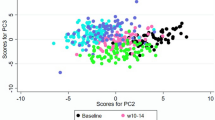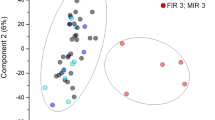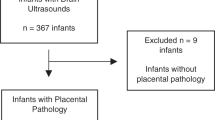Abstract
Amniotic fluid infection with chorioamnionitis is associated with increased risks of morbidity and mortality in children born prematurely. These risks depend on the presence of a fetal inflammatory response. We measured the concentrations of 25 proteins in the blood of 871 infants born before the 28th wk of gestation and examined their placentas for acute inflammation. Newborns who had inflammatory lesions of the placenta were much more likely than their peers (p < 0.01) to have elevated blood concentrations of cytokines (IL-1β, IL-6, and TNF-α), chemokines (IL-8, MIP-1β, RANTES, and I-TAC), adhesion molecules (ICAM-1, ICAM-3, and E-selectin), matrix metalloproteinases (MMP-1 and MMP-9), the angiogenic inflammatory factor VEGF and its receptor VEGF-R2, and acute phase proteins (SAA and CRP) during the first 3 d after birth. In contrast, newborns with poor placental perfusion had lower levels of inflammatory proteins (p < 0.01; IL-6, RANTES, ICAM-1, ICAM-3, VCAM-1, E-selectin, MMP-1, MMP-9, MPO, and VEGF). An inverse pattern was found between newborn levels of VEGF and its competitive inhibitor VEGF-R1 in both the inflamed and poorly perfused placenta categories. These results confirm the predictive value of placental histology for the presence or absence of elevated inflammatory response in newborns.
Similar content being viewed by others
Log in or create a free account to read this content
Gain free access to this article, as well as selected content from this journal and more on nature.com
or
References
Hillier SL, Martius J, Krohn M, Kiviat N, Holmes KK, Eschenbach DA 1988 A case-control study of chorioamnionic infection and histologic chorioamnionitis in prematurity. N Engl J Med 319: 972–978
Stoll BJ, Hansen NI, Adams-Chapman I, Fanaroff AA, Hintz SR, Vohr B, Higgins RD 2004 Neurodevelopmental and growth impairment among extremely low-birth-weight infants with neonatal infection. JAMA 292: 2357–2365
van Hoeven KH, Anyaegbunam A, Hochster H, Whitty JE, Distant J, Crawford C, Factor SM 1996 Clinical significance of increasing histologic severity of acute inflammation in the fetal membranes and umbilical cord. Pediatr Pathol Lab Med 16: 731–744
Hecht JL, Onderdonk A, Delaney M, Allred EN, Kliman HJ, Zambrano E, Pflueger SM, Livasy CA, Bhan I, Leviton A, ELGAN Study Investigators 2008 Characterization of chorioamnionitis in 2nd-trimester C-section placentas and correlation with microorganism recovery from subamniotic tissues. Pediatr Dev Pathol 11: 15–22
McElrath TF, Hecht JL, Dammann O, Boggess K, Onderdonk A, Markenson G, Harper M, Delpapa E, Allred EN, Leviton A 2008 Pregnancy disorders that lead to delivery before the 28th week of gestation: an epidemiologic approach to classification. Am J Epidemiol 168: 980–989
Leviton A, Allred EN, Kuban KC, Hecht JL, Onderdonk AB, O'Shea TM, Paneth N 2010 Microbiologic and histologic characteristics of the extremely preterm infant's placenta predict white matter damage and later cerebral palsy. The ELGAN study. Pediatr Res 67: 95–101
Fichorova RN, Trifonova RT, Gilbert RO, Costello CE, Hayes GR, Lucas JJ, Singh BN 2006 Trichomonas vaginalis lipophosphoglycan triggers a selective upregulation of cytokines by human female reproductive tract epithelial cells. Infect Immun 74: 5773–5779
Fichorova RN, Richardson-Harman N, Alfano M, Belec L, Carbonneil C, Chen S, Cosentino L, Curtis K, Dezzutti CS, Donoval B, Doncel GF, Donaghay M, Grivel JC, Guzman E, Hayes M, Herold B, Hillier S, Lackman-Smith C, Landay A, Margolis L, Mayer KH, Pasicznyk JM, Pallansch-Cokonis M, Poli G, Reichelderfer P, Roberts P, Rodriguez I, Saidi H, Sassi RR, Shattock R, Cummins JE Jr 2008 Biological and technical variables affecting immunoassay recovery of cytokines from human serum and simulated vaginal fluid: a multicenter study. Anal Chem 80: 4741–4751
Rothman KJ 1990 No adjustments are needed for multiple comparisons. Epidemiology 1: 43–46
Hecht JL, Allred EN, Kliman HJ, Zambrano E, Doss BJ, Husain A, Pflueger SM, Chang CH, Livasy CA, Roberts D, Bhan I, Ross DW, Senagore PK, Leviton A 2008 Histological characteristics of singleton placentas delivered before the 28th week of gestation. Pathology 40: 372–376
Pacora P, Chaiworapongsa T, Maymon E, Kim YM, Gomez R, Yoon BH, Ghezzi F, Berry SM, Qureshi F, Jacques SM, Kim JC, Kadar N, Romero R 2002 Funisitis and chorionic vasculitis: the histological counterpart of the fetal inflammatory response syndrome. J Matern Fetal Neonatal Med 11: 18–25
Mestan K, Yu Y, Thorsen P, Skogstrand K, Matoba N, Liu X, Kumar R, Hougaard DM, Gupta M, Pearson C, Ortiz K, Bauchner H, Wang X 2009 Cord blood biomarkers of the fetal inflammatory response. J Matern Fetal Neonatal Med 22: 379–387
Yoon BH, Romero R, Park JS, Kim M, Oh SY, Kim CJ, Jun JK 2000 The relationship among inflammatory lesions of the umbilical cord (funisitis), umbilical cord plasma interleukin 6 concentration, amniotic fluid infection, and neonatal sepsis. Am J Obstet Gynecol 183: 1124–1129
Weatherstone KB, Rich EA 1989 Tumor necrosis factor/cachectin and interleukin-1 secretion by cord blood monocytes from premature and term neonates. Pediatr Res 25: 342–346
Dammann O, Phillips TM, Allred EN, O'Shea TM, Paneth N, Van Marter LJ, Bose C, Ehrenkranz RA, Bednarek FJ, Naples M, Leviton A 2001 Mediators of fetal inflammation in extremely low gestational age newborns. Cytokine 13: 234–239
Romero R, Gomez R, Galasso M, Mazor M, Berry SM, Quintero RA, Cotton DB 1994 The natural interleukin-1 receptor antagonist in the fetal, maternal, and amniotic fluid compartments: the effect of gestational age, fetal gender, and intrauterine infection. Am J Obstet Gynecol 171: 912–921
Døllner H, Vatten L, Halgunset J, Rahimipoor S, Austgulen R 2002 Histologic chorioamnionitis and umbilical serum levels of pro-inflammatory cytokines and cytokine inhibitors. BJOG 109: 534–539
Redline RW 2006 Inflammatory responses in the placenta and umbilical cord. Semin Fetal Neonatal Med 11: 296–301
Salafia CM, Sherer DM, Spong CY, Lencki S, Eglinton GS, Parkash V, Marley E, Lage JM 1997 Fetal but not maternal serum cytokine levels correlate with histologic acute placental inflammation. Am J Perinatol 14: 419–422
Dammann O, Allred EN, Leviton A, Shen-Schwarz S, Heller D, Genest DR, Collins MH 2004 Fetal vasculitis in preterm newborns: interrelationships, modifiers, and antecedents. Placenta 25: 788–796
Lee SE, Romero R, Kim CJ, Shim SS, Yoon BH 2006 Funisitis in term pregnancy is associated with microbial invasion of the amniotic cavity and intra-amniotic inflammation. J Matern Fetal Neonatal Med 19: 693–697
Romero R, Espinoza J, Goncalves LF, Kusanovic JP, Friel L, Hassan S 2007 The role of inflammation and infection in preterm birth. Semin Reprod Med 25: 21–39
Gearing AJ, Newman W 1993 Circulating adhesion molecules in disease. Immunol Today 14: 506–512
Pigott R, Dillon LP, Hemingway IH, Gearing AJ 1992 Soluble forms of E-selectin, ICAM-1 and VCAM-1 are present in the supernatants of cytokine activated cultured endothelial cells. Biochem Biophys Res Commun 187: 584–589
Rothlein R, Mainolfi EA, Czajkowski M, Marlin SD 1991 A form of circulating ICAM-1 in human serum. J Immunol 147: 3788–3793
Porteu F, Nathan C 1990 Shedding of tumor necrosis factor receptors by activated human neutrophils. J Exp Med 172: 599–607
Maynard SE, Min JY, Merchan J, Lim KH, Li J, Mondal S, Libermann TA, Morgan JP, Sellke FW, Stillman IE, Epstein FH, Sukhatme VP, Karumanchi SA 2003 Excess placental soluble fms-like tyrosine kinase 1 (sFlt1) may contribute to endothelial dysfunction, hypertension, and proteinuria in preeclampsia. J Clin Invest 111: 649–658
Fowler DJ, Nicolaides KH, Miell JP 2000 Insulin-like growth factor binding protein-1 (IGFBP-1): a multifunctional role in the human female reproductive tract. Hum Reprod Update 6: 495–504
Lee SE, Han BD, Park IS, Romero R, Yoon BH 2008 Evidence supporting proteolytic cleavage of insulin-like growth factor binding protein-1 (IGFBP-1) protein in amniotic fluid. J Perinat Med 36: 316–323
Hansen AR, Collins MH, Genest D, Heller D, Shen-Schwarz S, Banagon P, Allred EN, Leviton A 2000 Very low birthweight placenta: clustering of morphologic characteristics. Pediatr Dev Pathol 3: 431–438
Hayashi T, Matsuoka K, Saitoh M, Takeda S, Kimura M 2006 Influence of alpha-tumor necrosis factor and beta-interleukin-1 on production of angiogenetic factors and thymidine phosphorylase activity in immortalized human decidual fibroblasts in vitro. J Obstet Gynaecol Res 32: 15–22
Ito TK, Ishii G, Saito S, Yano K, Hoshino A, Suzuki T, Ochiai A 2009 Degradation of soluble VEGF receptor-1 by MMP-7 allows VEGF access to endothelial cells. Blood 113: 2363–2369
Nath CA, Ananth CV, Smulian JC, Shen-Schwarz S, Kaminsky L 2007 Histologic evidence of inflammation and risk of placental abruption. Am J Obstet Gynecol 197: 319.e1–319.e6
Darby MJ, Caritis SN, Shen-Schwarz S 1989 Placental abruption in the preterm gestation: an association with chorioamnionitis. Obstet Gynecol 74: 88–92
Acknowledgements
We gratefully acknowledge the contributions of our subjects and their families, as well as those of their colleagues.
Author information
Authors and Affiliations
Consortia
Corresponding author
Additional information
Supported by a cooperative agreement with the National Institute of Neurological Diseases and Stroke Grant 5U01NS040069-05 and a center grant award from the National Institute of Child Health and Human Development (5P30HD018655-28).
Rights and permissions
About this article
Cite this article
Hecht, J., Fichorova, R., Tang, V. et al. Relationship Between Neonatal Blood Protein Concentrations and Placenta Histologic Characteristics in Extremely Low GA Newborns. Pediatr Res 69, 68–73 (2011). https://doi.org/10.1203/PDR.0b013e3181fed334
Received:
Accepted:
Issue date:
DOI: https://doi.org/10.1203/PDR.0b013e3181fed334
This article is cited by
-
Environmental influences on child health outcomes: cohorts of individuals born very preterm
Pediatric Research (2023)
-
Dried blood spot compared to plasma measurements of blood-based biomarkers of brain injury in neonatal encephalopathy
Pediatric Research (2019)
-
Histological chorioamnionitis and developmental outcomes in very preterm infants
Journal of Perinatology (2019)
-
Executive Dysfunction Early Postnatal Biomarkers among Children Born Extremely Preterm
Journal of Neuroimmune Pharmacology (2019)
-
Elevations of inflammatory proteins in neonatal blood are associated with obesity and overweight among 2-year-old children born extremely premature
Pediatric Research (2018)



